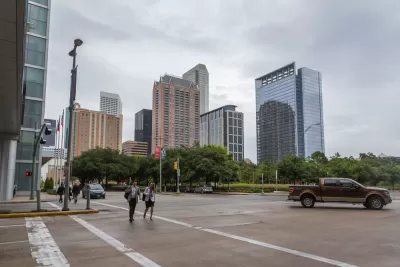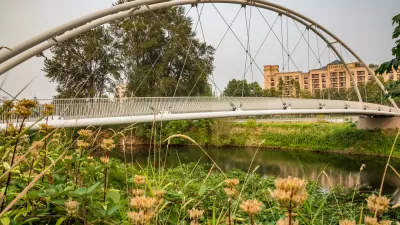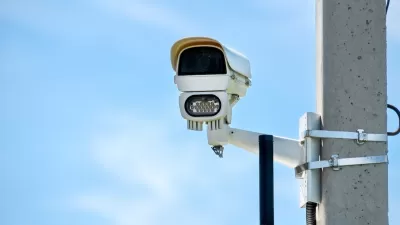The city's roadways were built to prioritize fast-moving traffic, not safety. With a new Vision Zero plan, that could change.

Why does Houston have so many pedestrian deaths? "[A]ccording to Houston’s chief transportation planner, David Fields, it’s because Houston roadways weren’t built primarily to protect pedestrians," reports Kirkland An. "'Historically, Houston has built its transportation to move people fast,' Fields said. 'And what that means is, we have not prioritized safety.'" Based on data from the city, "60% of traffic deaths and serious injuries occur on only 6% of its roads."
"Last year, Houston Mayor Sylvester Turner announced a Vision Zero plan: to reduce all traffic deaths—including pedestrian deaths—to zero by 2030," joining over 40 other cities that have taken a similar Vision Zero pledge. The plan "includes a citywide campaign on street safety, designing streets to support safer speeds and constructing sidewalks and bicycle facilities." In addition to speed limits and new safety infrastructure, "[t]he city also considers planning elements like 'corner radius, the width of the street, the width of each lane, and where you put parking,'" Fields told the Houston Chronicle.
Like in other cities around the country, "[t]hose affected [in Houston] were more likely to be part of low-income and minority communities." According to Fields, "[t]his tells us we have not invested equitably in safe transportation across the city." While the Vision Zero plan may seem ambitious for such a car-centric city, he says, "every life saved on the path to zero is valuable."
FULL STORY: Why are Houston's roads so dangerous and unwalkable? We prioritized driving fast.

Planetizen Federal Action Tracker
A weekly monitor of how Trump’s orders and actions are impacting planners and planning in America.

Congressman Proposes Bill to Rename DC Metro “Trump Train”
The Make Autorail Great Again Act would withhold federal funding to the system until the Washington Metropolitan Area Transit Authority (WMATA), rebrands as the Washington Metropolitan Authority for Greater Access (WMAGA).

The Simple Legislative Tool Transforming Vacant Downtowns
In California, Michigan and Georgia, an easy win is bringing dollars — and delight — back to city centers.

The States Losing Rural Delivery Rooms at an Alarming Pace
In some states, as few as 9% of rural hospitals still deliver babies. As a result, rising pre-term births, no adequate pre-term care and harrowing close calls are a growing reality.

The Small South Asian Republic Going all in on EVs
Thanks to one simple policy change less than five years ago, 65% of new cars in this Himalayan country are now electric.

DC Backpedals on Bike Lane Protection, Swaps Barriers for Paint
Citing aesthetic concerns, the city is removing the concrete barriers and flexposts that once separated Arizona Avenue cyclists from motor vehicles.
Urban Design for Planners 1: Software Tools
This six-course series explores essential urban design concepts using open source software and equips planners with the tools they need to participate fully in the urban design process.
Planning for Universal Design
Learn the tools for implementing Universal Design in planning regulations.
Smith Gee Studio
City of Charlotte
City of Camden Redevelopment Agency
City of Astoria
Transportation Research & Education Center (TREC) at Portland State University
US High Speed Rail Association
City of Camden Redevelopment Agency
Municipality of Princeton (NJ)





























